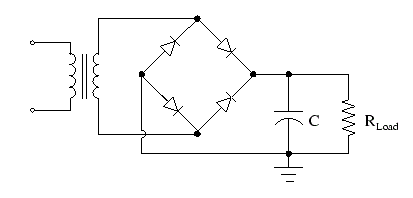
It's a balancing act between how much current you require, how much ripple noise is exceptable and how much inrush current is exceptable. To much in rush current can damage transformers ,rectifiers and even in some cases trip breakers. 125Vpp will require 33333uF (34,000 ♟), so on Also the more capacitance you add, the higher the inrush current. Every time you need to half the ripple, the capacitance will need to Double For. 008333 F = 8333uF (chose the next highest common value of 8400uF ) Now theirs something you need to be aware of. 5 amps of fully loaded current and your except-able ripple is 500mA.
#Bridge rectifier calculator full
C = I / 2 x f x Vpp C is the value of capacitor required in Farads multiply this value by 1000000 to get micro Farads I is the desired load current f is the the AC frequency of mains supply (60Hz) 2 is because the frequency is doubled in a full bridge rectifier (120Hz) Vpp is the exceptable peak to peak ripple when fully loaded for example you would like. I'd start with 1000uF if your application can tolerate 4V pk-pk ripple.Ĭalculators are fine but when your trying to learn it's much more informative to learn the formulas to get what you need. However that is rarely particularly useful due to the wide tolerance of most large electrolytic capacitors. Its a PITA to manually calculate, but is quite easy to solve graphically, if you want a better estimate of the capacitor value required for a particular pk-pk ripple. Therefore the actual ripple will be smaller. Of course, this doesn't allow for the fact the discharge line is a tangent to the falling side of the peak, so starts later than the peak and ends when it intercepts the rising side of the next peak rather than at the time of the peak itself.

This is the same calculation as the tool at Rstofer's link does. As a first approximation, 0.5A*8.33ms/100uF=41.7V drop, which is patently ridiculous as its comparable to the peak voltage so the ripple will obviously be grossly excessive. As a rough back of the envelope calculation, consider that the capacitor has to supply the load current between the ripple peaks, which occur at double the line frequency, i.e.


 0 kommentar(er)
0 kommentar(er)
